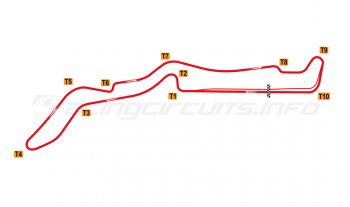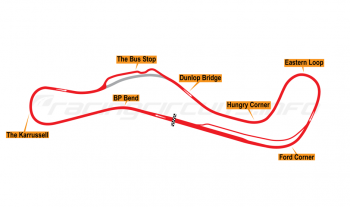Sachsenring
Circuit Overview
Once a classic road racing circuit behind the Iron Curtain, today's Sachsenring has been transformed into a modern arena where the world's best motorcycle riders can once more do battle in front of an enthusiastic crowd.
Home to the German MotoGP round since 1998, the track begins with a sinuous series of sweeping curves before opening out to fast back section with considerable elevation change.
As well as bike racing, it has been a mainstay of the ADAC GT Masters and other national championships on four wheels, as well as being one of the ADAC's major driver training facilities.
Circuit History
The origins of the circuit began in the mid-1920s, when two locals took on the task of organising races on the roads around the Saxony town of Hohenstein-Ernstthal. Sepp Wagner and Paul Berger had been inspired by other early motorcycle races in the area, including the Marienberg races which had begun a few years early. Despite some opposition from the locals, the pair formed a motorbike and by 1927 were ready to host racing.
A four-sided course, known as the Badberg Quadrangle, was laid out on public roads from Hohenstein-Ernstthal, running north parallel to the A4 autobahn until it turned back and headed south to the Queckenberg corner to complete the lap. The 8.618km course had a little of everything; flat out blasts, fast curves, slow hairpins, a run between the houses and alleyways of the town itself and considerable elevation changes as it wound out into the countryside.
The first race on Ascension weekend drew 140,000 spectators and 1928's event was no less popular. It also proved exceptionally treacherous, with no fewer than 41 accidents during its course, The Red Cross reported treating some 21 people during 133 calls for assistance. Understandably, local officials called a halt to proceedings.
It wasn't until 1934 that racing resumed, this time with the race hosting the prestigious Grand Prix of Germany, held as part of the prestigious European Motorcycle Championships. Unfortunately, the dangers were ever present and three riders were killed, including 1933 European Champion Gunnar Kalén and 1934 champion Pol Demeuter. The race continued on and in 1937 the circuit adopted the Sachensring name, after the closure of the Grillenburger Dreieck course in the Tharandter Forest, which had previously used the moniker. Sadly, that year saw the death of Scotsman Jimmie Guthrie, who had become the crowd favourite after victories in the 1935 and '36 races.
Circuit becomes East Germany's racing hub
War called a halt to proceedings, but racing resumed in 1949 and the crowds soon returned. The 1950 event, a round of the All-German Motorcycle Championships saw 480,000 spectators in attendance. In 1961, the race really hit its stride, however, when it was included as the East German round of the World Motorcycle Championships. The local two-stroke MZ machines were competitive with the visiting manufacturer equipment, with Ernst Degner duly taking victory in the 125cc race.
Over the next decade, the stars of world motorcycle racing all paid a yearly visit to Saxony, with Mike Hailwood and Giacomo Agostini providing multiple victories to thrill the crowds. Another crowd pleaser, British 125cc World Champion Bill Ivy, became another tragic addition to the roster of fatalities in 1969, when he was thrown from his bike after a suspected seized piston.
Into the 1970s, the East German Communist authorities began to view the event with some suspicion, particularly as it only served to highlight the growing disparity between home grown machinery and the visiting foreign bikes. When West German Dieter Braun took victory in the 1972 250cc race, the circuit loudspeakers were silenced while the national anthem was played. It was clear that the race's status as a World Championship event was over.
Between 1973 and 1989 the race continued, but only for riders and machinery from behind the iron curtain. Car races were part of the mix too – from the early days there had always been some four-wheel action – but now took greater prominence thanks to a lack of permanent circuits elsewhere in East Germany and the dilution of the allure of the motorcycle event.
Still the event was little more than a closed road event, with a few wooden grandstands catering for the fans and nothing better than hay bales to protect the drivers, riders and spectators. Deaths continued and, when more powerful machinery became available in 1990 following the fall of the Berlin Wall, it was clear that the circuit was simply inadequate for modern racing, despite the addition of a couple of chicanes.
New driver training facility helps revive racing
In 1995, a new driver training facility was opened by the ADAC Sachsen, with a multi-use facility being created to the south of the original circuit. Quickly, momentum gathered to revive racing on this new course and, following some initial modifications, the new Sachsenring opened for business in 1996. Only a small portion of the original course featured in this new incarnation and even this was run in the opposite direction to previously.
Initial events included the German Superbike Championship and the popular STW Cup for 2-litre touring cars. A massive crash for British driver Warren Hughes in the latter perhaps highlighted that there was still some room for improvement and further changes came in subsequent years. The pit lane was switched to the opposite side of a lengthened main straight in 1998, and a variety of corners were eased and run-off areas improved. The final chicane was modified, speeding the lap considerably.
In 1998, the circuit achieved the highest level of FIM certification, allowing the return of the World Motorcycle Championships for the first time. The new twisty course was among the shortest and slowest on the calendar and proved a sharp contrast to the old course, but nevertheless the fan attendance was impressive, some 142,000 turning out to watch Mick Doohan speed to victory.
Further changes came in 2000, when the chicane leading onto the original stretch of the road course was eliminated, creating greater run off in the process. The DTM made its debut, becoming the highest category of car racing to compete at the circuit. The series stayed until 2002, after which it it headed off to a new East German home at the Lausitzring.
Still the circuit authorities were not fully satisfied and more major changes came ahead of the 2001 season, when a new end section of the lap was developed by Hermann Tilke, as well as the re-alignment of the the pit straight, with new garages and and paddock created one the inside of the new loop. Tilke's revisions included a dramatic plunging downhill right-hander leading onto the new back section, which quickly acquired the nickname of 'The Waterfall'. The changes also meant the the circuit was completely enclosed for the first time, becoming a truly permanent facility divorced from any public roads.
Further slight revisions in 2003 to Omega Curve and a programme of general track maintenance have been the last alterations to a circuit which, like its predecessor, has became a firm fixture on the motorcycling calendar, as well as enjoying a yearly visit from the popular ADAC GT Masters championship.
Jump onboard
Circuit info
- ADAC Sachsen, PF 16 02 62, 01288 Dresden, Germany
- +49 351 4433190
- Email the circuit
- Official website
Rate This Circuit
Votes: 6885
Get your race tickets!
Brought to you with: 
We've teamed up with Motorsports Tickets to bring you the best deals for Formula One, MotoGP, Le Mans and more.

















